
Posted on 01/07/2014 4:54:25 AM PST by Homer_J_Simpson

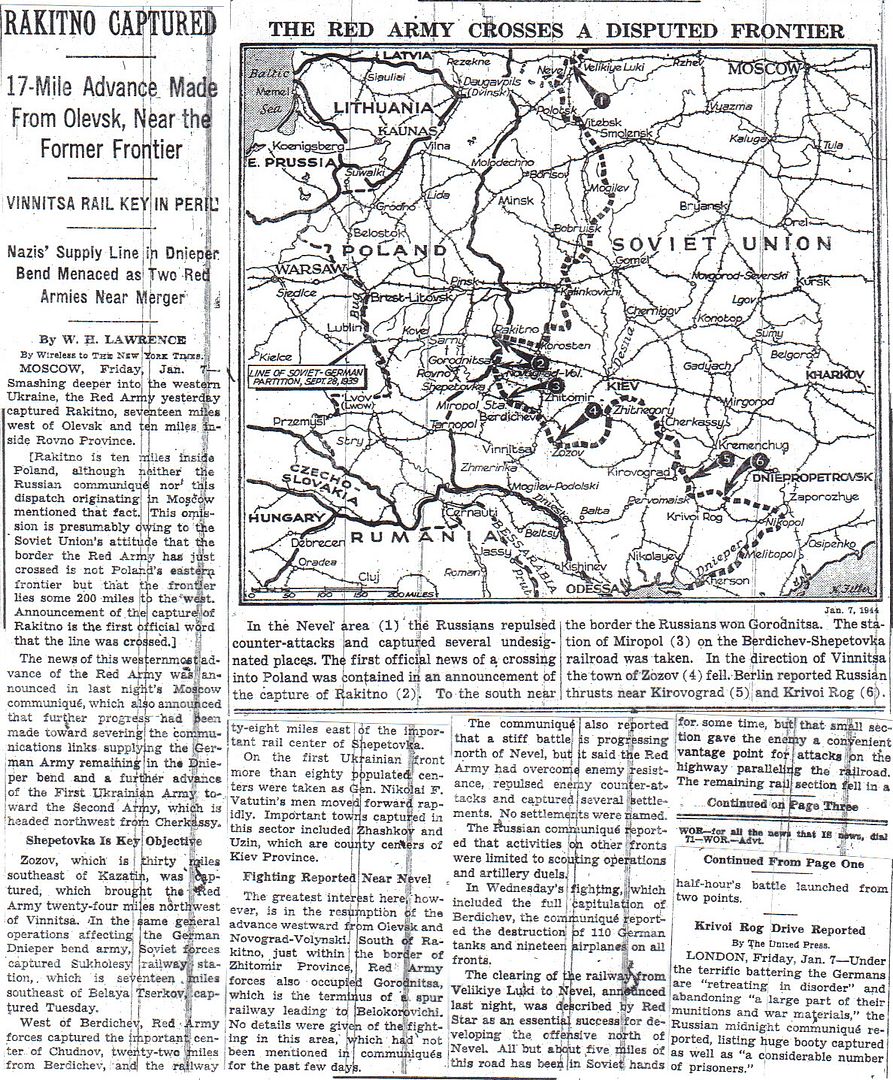
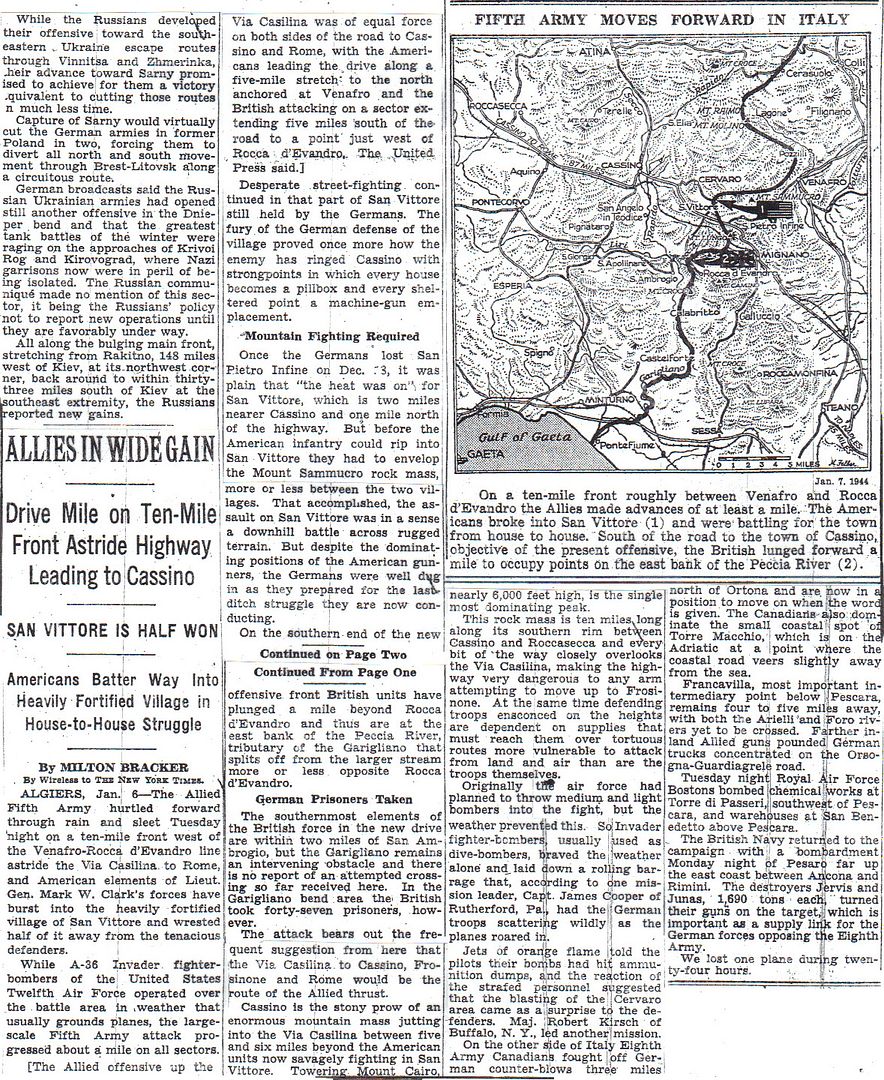

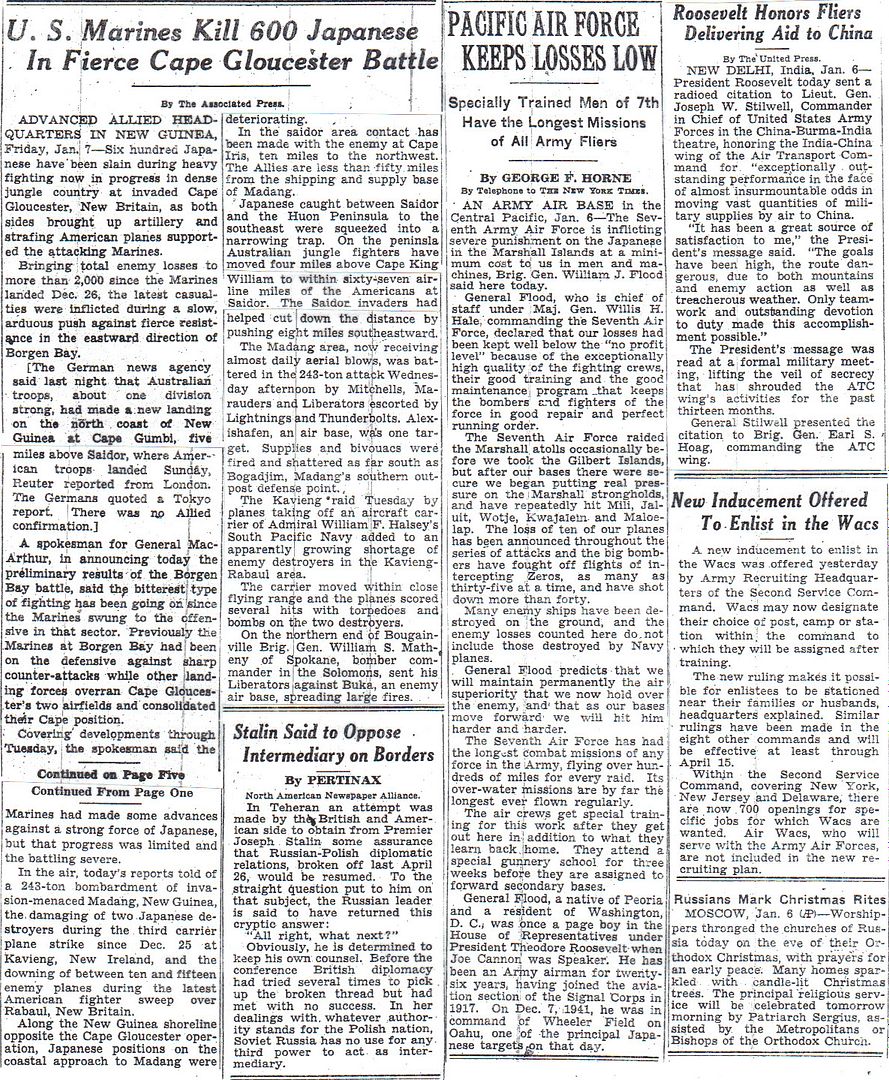

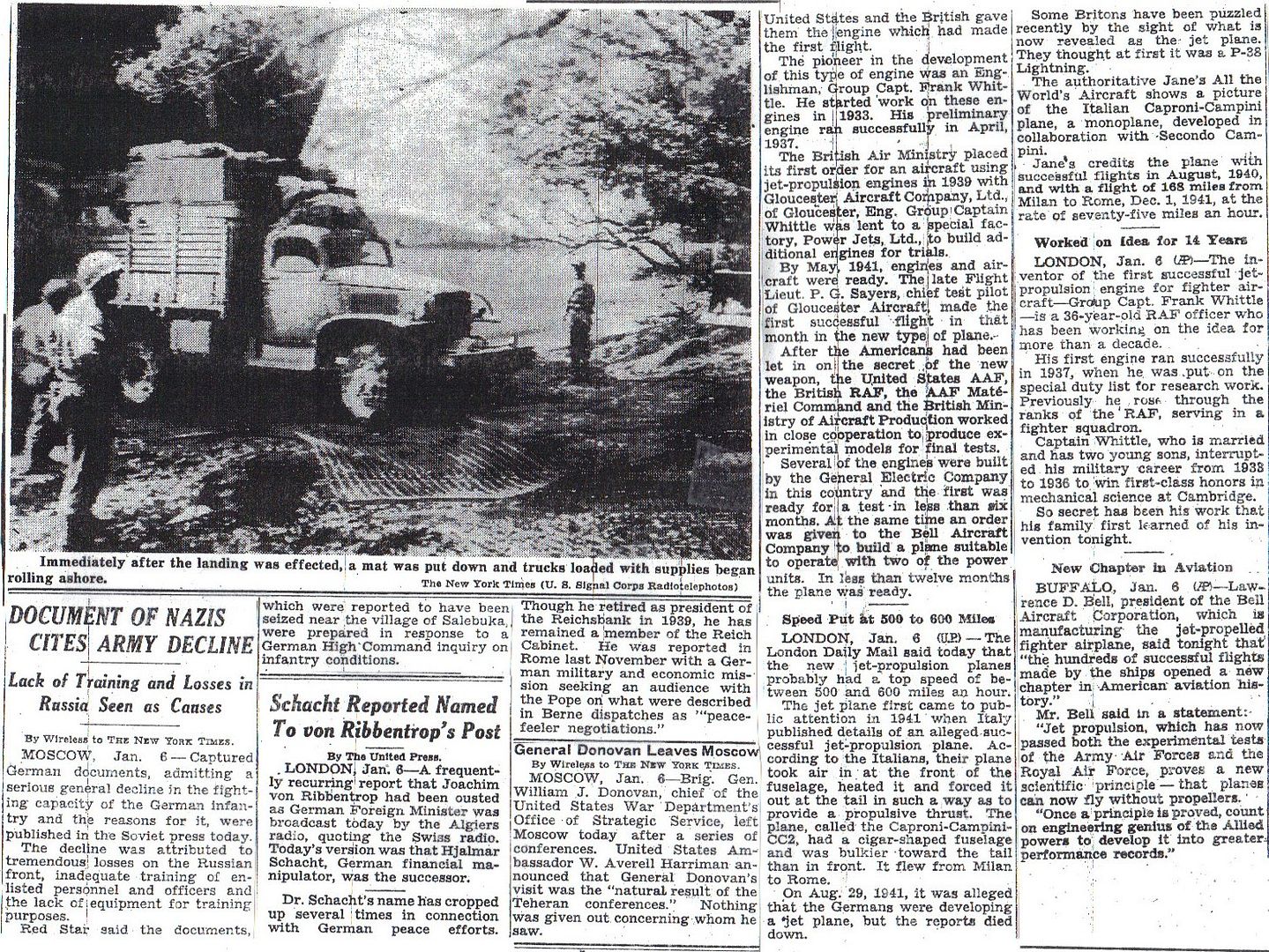
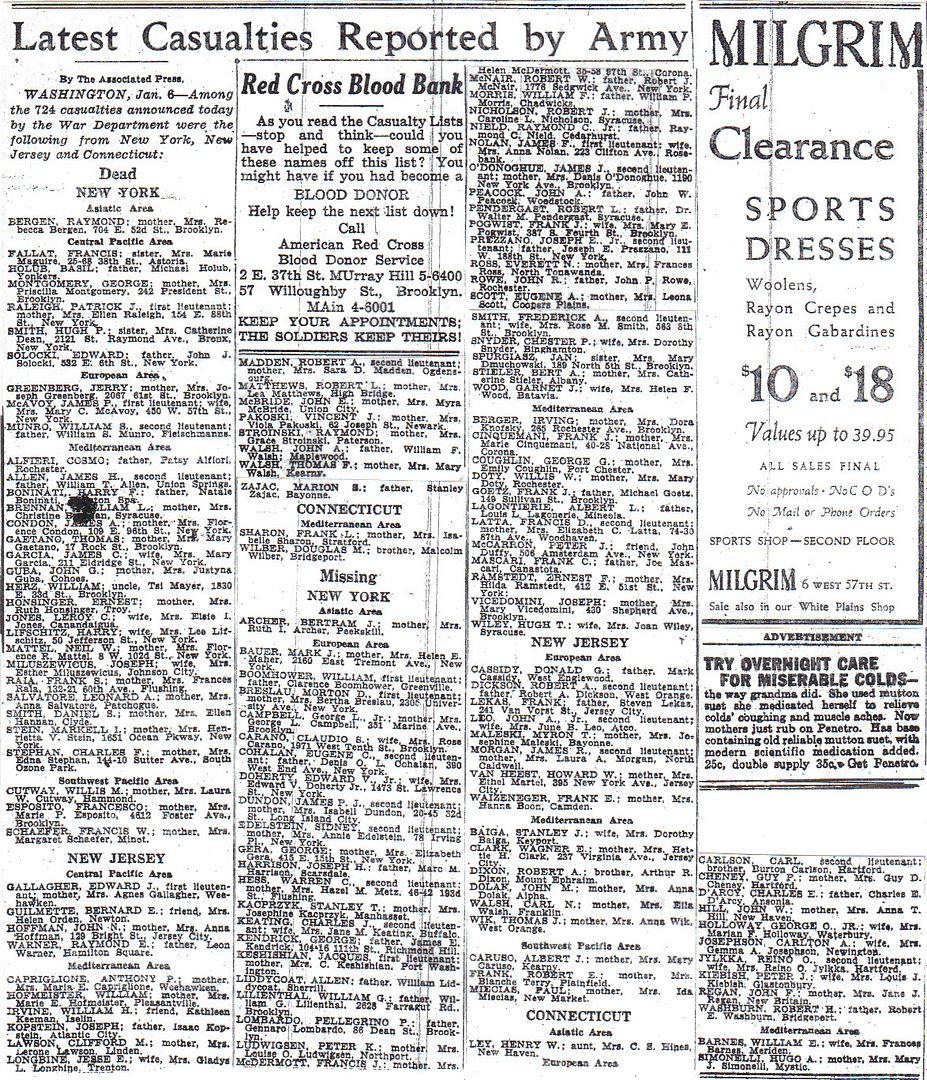
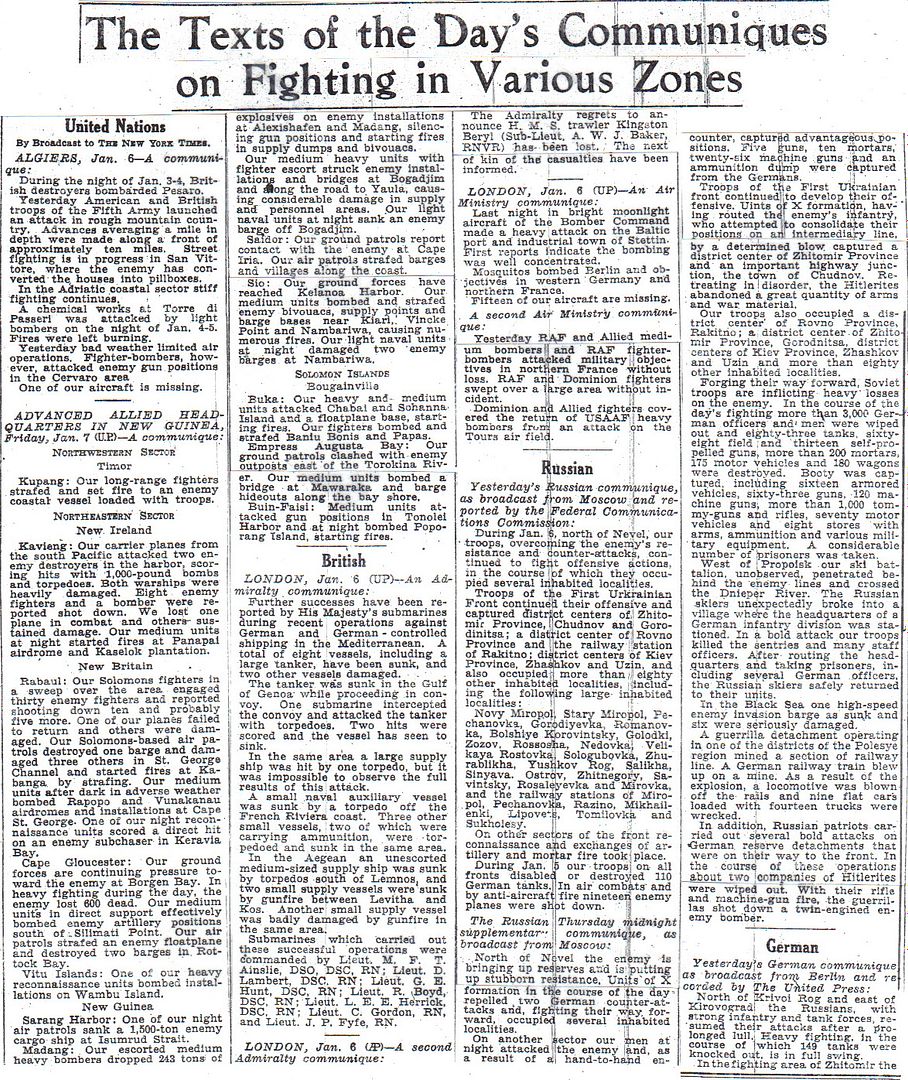

7 January. 1st Battalion patrols covered their assigned inland area, but met no enemy.
The 2d Battalion sent out a patrol of one platoon to explore inland trails for enemy activity.
At 1710 our patrol near Sel was strafed by our own aircraft. No casualties or damage.
The 3d Batallion patrols discovered no enemy.
Of the twelve LCMs sent to this task force from Cape Cretin two were returned as unserviceable, three were being repaired, and four were stuck on reefs, and this left three for duty. So six additional LCMs were requested in order to supply outlying units which could not be reached by roads.
The Lulais and Tultuls chiefs and sub-chiefs of the tribes from surrounding villages reported in for a conference. They went away to bring in still more natives.
There were no roads to our flank positions which were many miles apart, only trails impassable for wheeled vehicles. The only way of getting supplies and heavy equipment to the flanks was by landing craft. Heavy ground swells often kept these craft from landing on the beaches. In view of these difficulties and the enemy threat, a recommendation was made to Sixth Army on 10 January that additional combat troops be sent to the Saidor area.
Sixth Army messages still warned of enemy army and marine units assembling to eastward. They estimated 5,000 or 6,000 enemy combat troops on the coast east of Saidor.
Major General H.W. Blakeley, USA, Ret., The 32d Infantry Division in World War II
http://www.onwar.com/chrono/1944/jan44/f07jan44.htm
Allies capture San Vittore
Friday, January 7, 1944 www.onwar.com
American mortar crew supporting attacks in Italy [photo at link]
In Italy... British and American elements of the US 5th Army capture Monte Chiaia and Monte Porchia. San Vittore is also taken.
On the Eastern Front... Soviet forces in the Ukraine continue advancing toward Kirovograd (2nd Ukrainian Front) and toward the former Polish town of Rovno.
In Occupied France... French resistance members sabotage the electricity supply to the Arsenal National at Tulle in the first of many such attacks.
Over Germany... A British Mosquito reconnaissance bomber is shot down by German anti-aircraft fire and its Oboe navigational aid is captured intact. This enables the Germans to devise counter-measures.
http://www.etherit.co.uk/month/thismonth/07.htm
January 7th, 1944 (FRIDAY)
UNITED KINGDOM: Major James Stewart of the USAAF, better known as the star of The Philadelphia Story, brought his Liberators back intact today from a daylight mission on Ludwigshaven, despite being set upon by enemy fighters. Stewart, leading 48 bombers of 445th Group based at Tibenham in Norfolk, had completed his mission when he saw that the 389th Group, the lead group of the raid’s original 420 bombers, had taken a wrong bearing home, across German fighter airfields in France. Radio contact was lost, so he decided to follow and gave fire cover. Owing to Stewart’s action, only eight of the strayed Liberators were lost.
Whilst in the tow of submarine HMS Syrtis, miniature submarine X-22 is run down by her and sunk, when Syrtis reverses course to search for a man washed overboard. All 3 of the crew of X-22 are lost. Location: Pentland Firth, Scotland. (Alex Gordon)(108)
Frigate HMS Taff commissioned.
FRANCE: Paris: Eugène Deloncle, a leading member of the RNP and Parisian gangster employed by the Germans is shot by a squad of his former SD accomplices at his apartment, also wounding his son. His wife and assistant, Jacques Corrèze, are then accused of the crime.
South-eastern FRANCE: Allied advisers parachute in to train Resistance fighter for guerrilla warfare after the invasion of Europe.
Thirty five USAAF Ninth Air Force B-26 Marauders bomb Maupertus Airfield at Cherbourg. Bad weather restricts further operations.
During the night of 7/8 January, the USAAF Eighth Air Force flies Mission 179: five B-17 Flying Fortresses drop 1.08 million leaflets on Paris, Chartres, Caen and Evreux without loss.
GERMANY: The USAAF Eighth Air Force flies Mission 178: 351 of 382 B-17 Flying Fortresses and 69 of 120 B-24s hit the I G Farben synthetic oil plant at Ludwigshafen; they claim 30-6-17 Luftwaffe aircraft; five B-17 Flying Fortresses and 17 B-24s are lost. Four other aircraft bomb targets of opportunity.
During the night of 7/8 December, RAF Bomber Command dispatches Mosquitos to bomb Duisburg (four hit the Vereinigte Stahl steel factory and one bombs the city) and Krefeld (three attack the Edelstahlwerke steel factory and three bomb the city).
U-1234 launched
U-368 commissioned.
Southern ITALY: The British X Corps and the US II Corps have broken through the Germans’ winter defensive line. The village of San Vittore fell yesterday and today, after a vicious battle, the Germans were driven off Monte Porchia. But the British 46th Division has been forced back after several attempts to get its tanks across the flooded river Peccia; no longer do the Allies talk of a “jolly romp to Rome.”
Every yard of this mountainous terrain has to be fought for against a Wehrmacht which has recovered quickly from the loss of its Italian allies and shows no sign of retreating to a defensive line north of the Italian capital. However, a major Allied attack is imminent.
General Mark Clark is anxious to draw off the maximum number of German reserves before the seaborne landings at Anzio planned for January 22. The Germans have meanwhile established defensive positions at the far end of the Liri valley - in the mountains overlooking Cassino.
In the U.S. Fifth Army’s II Corps area, Mt. Porchia falls to Task Force A of the 1st Armoured Division, making nearby Cedro Hill, in the British X Corps zone, untenable for the Germans. The 135th Infantry Regiment, 34th Infantry Division, occupies Mt. La Chiaia and continues west, clearing Hill 224 and Cicerelli Hill, between Mt. La Chiaia and Highway 6 while the 168th Infantry Regiment gains control of a ridge northeast of La Chiaia, contributing to success of the 135th Infantry Regiment. The right flank column of Task Force B, 1st Special Service Force, takes Mt. Majo early in the day and holds it against a series of counterattacks while column on the left attempts to reduce Hill 1109, overlooking Cervaro, without success.
USAAF Twelfth Air Force B-25 Mitchells strike Perugia Airfield; A-20 Havocs hit defenses in close support of the US Fifth Army; B-26 Marauders hit the marshalling yards at Foligno and Arezzo and attack a bridge at Roccasecca; A-36 Apaches hit gun positions, trucks, and trains in the Cervaro-Aquino-Cassino area, bomb the Aquino station, and hit the Velletri railway yards; P-40s give close support in the Monte Maio, Monte La Chiaia, Monte Porchia, and Cedro Hill areas as the US Fifth Army drives toward the Rapido River.
Twenty one USAAF Fifteenth Air Force B-17 Flying Fortresses, with P-38 Lightning escort, bomb a torpedo plant at Fiume.
During the night of 7/8 December, 26 heavy bombers of the RAF No. 205 (Heavy Bomber) Group bomb the aircraft plant at Reggio-Emelia.
U.S.S.R.: Moscow announces a breakthrough on the 60-mile (97 kilometre) front in the Kirovograd sector. Kirovograd is practically surrounded.
YUGOSLAVIA: Eight USAAF Fifteenth Air Force B-17 Flying Fortresses bomb the port area at Split.
CEYLON: Admiral Louis Mountbatten, Supreme Commander Southeast Asia Command, drops plans for Operation CUDGEL, small-scale operation in the Arakan coastal sector of Burma.
JAPAN: Imperial General Headquarters authorizes the Southern Army to secure positions in the Imphal area of India when the opportunity presents itself.
CHINA: Four USAAF Fourteenth Air Force B-25 Mitchells and six P-40s sink two large boats on the Yangtze River south of Hukow and sink a large powerboat, a barge, and a small ore craft at Shihhweiyao; 11 P-38 Lightnings claim between 30 and 40 sampans destroyed along the river from Hankow to Chiuchiang; and two B-25s on a sea sweep claim a 300-foot (91 meter) passenger vessel sunk south of Hong Kong.
BURMA: Seven USAAF Tenth Air Force B-25 Mitchells and 15 P-38 Lightnings attack the Lanywa area, hitting the oil plant and storage tanks, causing several fires, and strafe several antiaircraft positions while 19 A-36 Apaches and P-51 Mustangs bomb supply and troop concentrations at Nanyaseik.
NEW GUINEA: In Northeast New Guinea, USAAF Fifth Air Force B-24 Liberators, B-25 Mitchells, P-39 Airacobras, and P-47 Thunderbolts attack the Alexishafen-Madang area, hit Erima, Bogadjim, and targets along the Bogadjim Road, attack positions from Weber Point to Vincke Point, and strafe huts and barges near Sidor.
EAST INDIES: USAAF Fifth Air Force B-24 Liberators hit Boela on Ceram, Netherlands East Indies.
ADMIRALTY ISLANDS: USAAF Fifth Air Force B-24 Liberators hit Lorengau, Manus Island.
BISMARCK ARCHIPELAGO: On New Britain Island, USAAF Fifth Air Force B-24 Liberators bomb the Cape Gloucester area and A-20 Havocs hit forces near Arawe.
About 150 USMC and USN SBD Dauntlesses and TBF Avengers, escorted by 72 fighters, attack targets on the Cape Saint George area, New Ireland Island. USAAF Thirteenth Air Force B-24 Liberators bomb Vunakanau Airfield on New Britain Island.
PACIFIC OCEAN: The submarine U.S.S. Kingfish (SS-234), on her sixth patrol, is patrolling the waters off Palawan. At position 9-27N 117-36E, she attacks on the surface at night using her radar. Of the four torpedoes fired, two fish hit the vessel and sink the C-AO Fushimi Maru #3 (4289T). (Chris Sauder)
CANADA: HMC MTB 727 commissioned.
Frigate HMCS Royalmount laid down.
U.S.A.: Frigate USS Gladwyne launched.
Destroyer escort USS Kephart commissioned.
Submarine USS Perch commissioned.
ATLANTIC OCEAN: River class frigate HMS Tweed (K 250), part of Escort Group 5, takes a Zaunkönig hit from U-305 (Kapitanleutnant Rudolf Bahr) and sinks within two minutes. There are 52 survivors. Location: West of Cape Ortegal at 44 18N 21 19W. (Alex Gordon)(108)
River class frigate HMCS Waskesiu was narrowly missed by a Zaunkönig torpedo, which carried on to strike sister ship HMS Tweed. TWEED sinks within two minutes. There are 52 survivors. Location: West of Cape Ortegal at 44 18N 21 19W. Both were part of Escort Group 6, which had been carrying out ‘offensive ASW sweeps’ in the Bay of Biscay. The attack was conducted by U-305, Kapitanleutnant Rudolf Bahr, CO. (Alex Gordon and Dave Shirlaw)(108)
U-107 was attacked four times (at 0008hrs, 0040hrs, 0104hrs, and 0120hrs) by Liberator aircraft, and replied each time with Anti-Aircraft guns. The boat suffered no damage.
U-343 shot down RAF 36 Sqn Wellington. The boat survived a swamp operation, shooting down one of its attackers.
Page 6 article about the birth of operational jet aircraft.
I wonder how many people understood the magnitude of the impact this would have on aviation?
The advertisement for post war products is interesting, revealing and in many ways would have been encouraging. Two edged sword and may have been a very small part in leading to the atomic bomb use in Japan?
New inducements to enlist in the WACS still indicates a manpower shortage for the war.
In the article “on August 21, 1941, the Germans were reported to be developing a jet plane, but then reports died down.
I wonder what stage of development the 262 was at that point?
No reference yet to English and American development yet so was still pretty much a secret?
oops, didn’t read the whole article before posting.
.............the authoritive Janes ....................(referenced in the article)
http://en.wikipedia.org/wiki/Jane%27s_All_The_World%27s_Aircraft
interesting history and vision on Janes
They're not drafting women yet. Imagine the reaction if anyone had suggested putting women in combat roles.
“I wonder what stage of development the 262 was at that point?”
From Wiki:
“Plans were first drawn up in April 1939, and the original design was very similar to the aircraft that eventually entered service. The progression of the original design was delayed greatly by technical issues involving the new jet engine. Funding for the jet engine program was also initially lacking as many high-ranking officials thought the war could easily be won with conventional aircraft.[11] Among those were Hermann Göring, head of the Luftwaffe, who cut the engine development program to just 35 engineers in February 1940; Willy Messerschmitt, who desired to maintain mass production of the piston-powered Bf 109 and the projected Me 209; and Major General Adolf Galland, who supported Messerschmitt through the early development years, flying the Me 262 himself on 22 April 1943. By that time, problems with engine development had slowed production of the aircraft considerably. One particularly acute problem arose with the lack of an alloy with a melting point high enough to endure the high temperatures involved, a problem that by the end of the war had not been adequately resolved.[11]”
http://en.wikipedia.org/wiki/Messerschmitt_Me_262

50 were produced, 20 P-59A's and 30 P-59B's. The aircraft had a lot of problems and never saw combat. It compared unfavorably to the British jet prototype and Americans would rather fly the Mustang. Still, the US got valuable experience and knowledge out of the project.
The competing Lockheed P-80 was more successful, but also was not operational by the end of the war. At least the Gloster Meteor got into combat.
Back when I posted this issue of 70-year-old WWII news I omitted this important item for some reason. My uncle’s B-17 crew (Chason was pilot) Went on Mission #3. From the unit war diary:
7. With allied fighters virtually flying formation with them throughout the operation, hundreds of American bombers rode triumphantly to Ludwigshafen today to knock out one of Germany’s most important industrial centres. The 381st provided 25 B-17s over the target, seven from this squadron, led by their commander Major George G. Shackley, of Greenwood Lake, N.J.
He flew lead with 1st Lt William J. McDaniel on “Sweet and Lovely”; the composite group was led by Capt Marvin D. Lord, with Lt Bill Ridley, other pilots being: Lts Parsons, Chason, Sandman, Thompson, Hanson (534th ship), Nason (535th ship) and Shultz.
http://381st.org/Unit-Histories/War-Diaries/533rd-Bomb-Squadron-War-Diary
Disclaimer: Opinions posted on Free Republic are those of the individual posters and do not necessarily represent the opinion of Free Republic or its management. All materials posted herein are protected by copyright law and the exemption for fair use of copyrighted works.